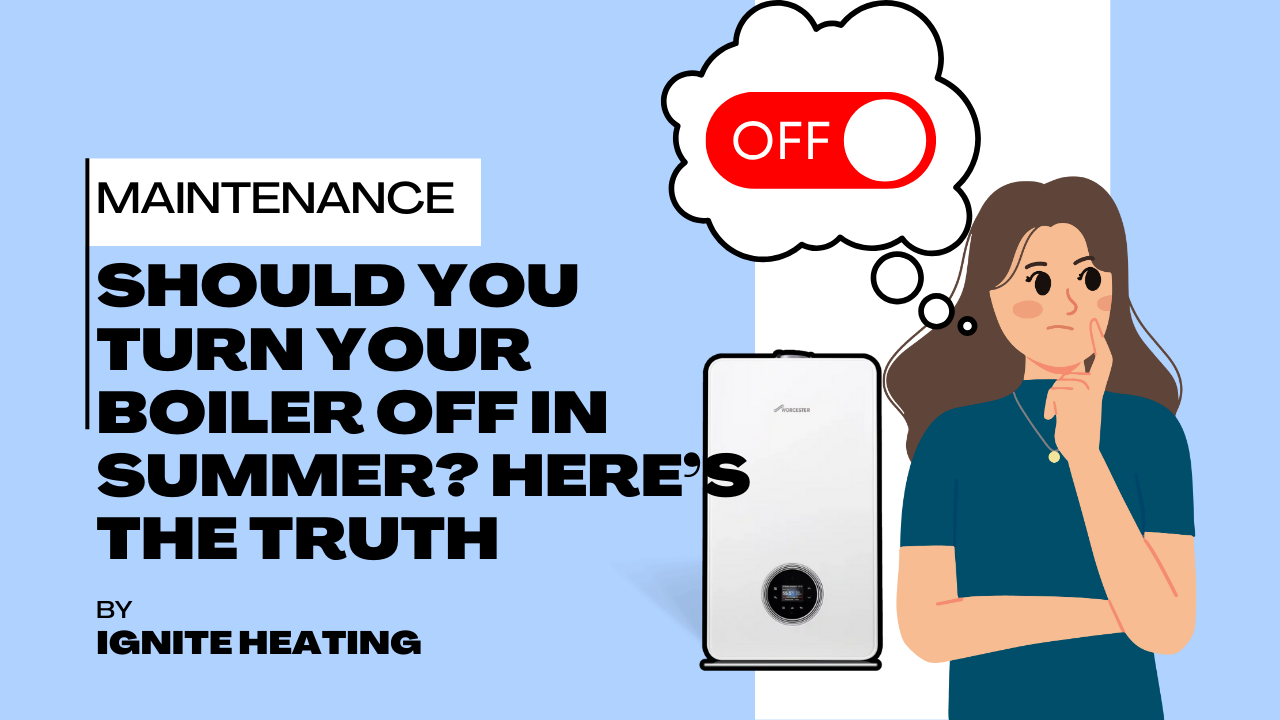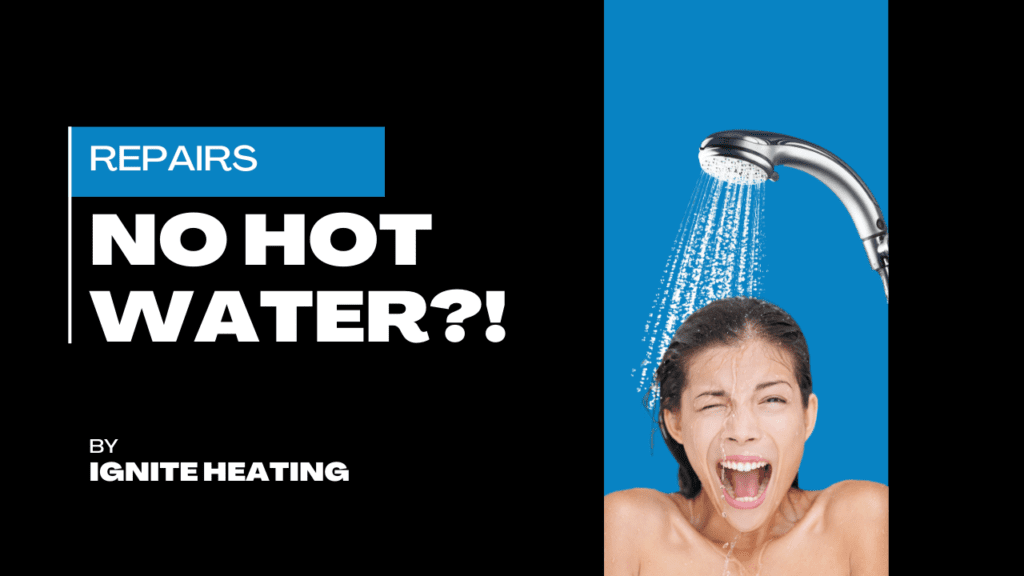
Should You Turn Your Boiler Off in Summer? Here’s the Truth.
Search Should You Turn Your Boiler Off in Summer? Here’s the Truth. Summer’s here finally. The sun’s shining (most days),

Hot water is essential for everyday tasks—whether it’s showering, washing dishes, or running household appliances. So when it suddenly stops, it can be a major inconvenience. The good news? Most hot water issues stem from common, fixable problems.
✅ Boiler malfunctions – low pressure, faulty pilot lights, or broken thermostats
✅ Tripped circuit breakers – disrupting power to your water heater
✅ High demand – using more hot water than usual
✅ Frozen pipes – often an issue in cold weather
While some problems can be resolved with quick troubleshooting, more complex issues require a professional touch. A qualified heating engineer can diagnose and repair faults efficiently, ensuring your system runs safely and effectively.
Your boiler is the heart of your heating system. If it’s not working properly, hot water will be the first thing to go.

Low Pressure
Boilers need adequate pressure (1-2 bar) to function efficiently.
Check the pressure gauge; if it’s too low, follow your manual’s instructions to re-pressurize it.
🔥 Pilot Light Won’t Stay Lit
A faulty thermocouple (which controls gas flow) may be to blame.
If the pilot light goes out repeatedly, consult a heating engineer.
🌡️ Thermostat Problems
A broken thermostat can prevent your boiler from heating water.
Check the settings and replace batteries if needed.
💨 Airlocks in the System
Trapped air can block hot water circulation, causing gurgling pipes or cold radiators.
Bleeding radiators (releasing trapped air) often fixes the issue.
🛠 Sediment Buildup
Over time, sludge and debris can clog up your boiler, reducing efficiency.
Regular servicing and installing a magnetic filter help prevent blockages.

If your boiler or water heater isn’t heating properly, a broken internal component may be to blame. Over time, key parts can wear out, causing lukewarm or no hot water at all.
🔩 Heating Element (Electric Water Heaters)
Located inside electric water heaters, this warms the water.
Signs of failure: Lukewarm or no hot water.
Fix: A heating engineer can test and replace the element.
🔀 Diverter Valve (Combi Boilers)
This switches hot water between your taps and radiators.
If faulty, you might have heating but no hot water.
Fix: A stuck or broken valve needs a professional repair or replacement.
🔥 Heat Exchanger
Transfers heat from the gas burner to the water.
If blocked by limescale or sludge, it won’t heat efficiently.
Fix: A heating engineer can flush or replace it.
🖥️ PCB (Printed Circuit Board)
The brain of your boiler – controls all functions.
A faulty PCB can cause error codes, shutdowns, or no response.
Fix: Needs a diagnosis & potential replacement by an engineer.
Annual servicing – Catches early signs of wear & tear.
Magnetic filters – Reduce sludge buildup in the system.
Water softeners – Prevent limescale buildup in hard water areas.
If you suspect a faulty component, don’t attempt DIY repairs – get a professional to avoid further damage.

Leaks are one of the biggest threats to your heating system. Even small drips can lead to water damage, pressure loss, and boiler failure.
🚰 Water Cylinder Leak
Found in traditional systems with separate tanks.
Causes: Rust, corrosion, or cracks in the tank.
Fix: If the cylinder is leaking, it will likely need replacement.
🔥 Boiler Leak
A leaking boiler can result in low pressure and no hot water.
Causes:
Corroded pipes or internal parts – This happens over time, especially in older systems.
Faulty seals or gaskets – Can allow water to escape from within the boiler.
Pressure issues – Excessive pressure can force water out through safety valves.
Fix: Shut off the water supply and call an engineer ASAP.
🛠 Pipework Leaks
Leaks in pipes feeding your boiler or radiators can affect your system’s efficiency.
Fix: Look for damp patches, water pooling, or drips and get them fixed promptly.
Check for leaks regularly – Inspect areas around your boiler, radiators, and pipe connections for drips, rust, or damp spots.
Install a magnetic filter – This helps trap sludge and debris, preventing corrosion and keeping your system running efficiently. 🚀🔥

If your boiler or electric water heater suddenly stops, a tripped circuit breaker could be the cause.
⚡ How to Check & Reset Your Breaker:
Locate your home’s fuse box (often in basements, garages, or storage rooms).
Find the breaker switch labelled “Water Heater” or “Boiler.”
If it’s flipped to the “off” position,” reset it by flipping it back to “on.”
If it trips again immediately, this suggests an electrical fault.
⚠️ Possible Causes of a Tripped Breaker:
Overloaded Circuit: Too many appliances using power at once.
Faulty Wiring: Old or damaged wiring in the system.
Broken Heating Element (Electric Boilers/Water Heaters): A short-circuiting element can cause repeated breaker trips.
🔧 When to Call an Expert:
If the breaker keeps tripping
If there’s a burning smell near the fuse box
If you notice scorch marks around the breaker panel
Avoid overloading circuits – Don’t run too many appliances on the same breaker to prevent tripping.
Get a professional check-up – If your heating system trips frequently, have an electrician inspect the wiring to ensure everything is safe and up to code.

During cold months, pipes supplying water to your boiler can freeze, blocking water flow and preventing heating.
❄️ Signs Your Pipes Are Frozen:
🚫 No hot water coming from taps
🚫 Gurgling sounds from pipes
🚫 Visible frost on external pipes
🚫 Boiler showing low pressure or error codes
🔥 How to Thaw Frozen Pipes Safely:
Turn off the boiler to prevent damage.
Locate the frozen pipe – Commonly found in unheated areas like garages, attics, or external walls.
Apply gentle heat – Use a hairdryer, heating pad, or warm towels to thaw the ice.
Start at the tap end and work backwards toward the frozen section.
Once thawed, reset your boiler and check if the water runs normally.
🚨 What NOT to Do:
❌ Don’t use open flames (like blowtorches) – Fire hazard!
❌ Don’t force the tap on full blast – Can cause pressure buildup and pipe bursts.
Insulate exposed pipes – Use foam pipe covers to protect pipes in unheated areas like garages, attics, and basements.
Keep heating on low – Set your heating to a low, steady temperature overnight to prevent freezing and keep water flowing.

Sometimes, no hot water is due to incorrect timer or thermostat settings rather than a system fault. Before calling a professional, check these common issues:
📅 Incorrect Timer Settings
🛠️ Issue: Many modern heating systems allow you to schedule hot water times. If the timer is set incorrectly, your boiler may not turn on when needed.
✅ Fix: Double-check your on/off schedule and adjust if necessary.
If there’s been a power cut, your timer may have reset to default settings—reprogram it accordingly.
Some timers have a boost function—try using it to see if the boiler responds.
🌡️ Thermostat Set Too Low
🛠️ Issue: If your thermostat is set below 60°C, your water may not get hot enough.
✅ Fix: Increase the hot water temperature to at least 60°C for optimal heating.
If you have a cylinder thermostat, ensure it’s not set too low (typically between 55°C – 65°C).
🔋 Dead Batteries in Wireless Thermostats
🛠️ Issue: Wireless thermostats need batteries to communicate with the boiler. If they die, the boiler may not receive heating signals.
✅ Fix: Replace batteries and reset the thermostat if needed.
If the thermostat display is blank or flashing low battery, install fresh batteries immediately.
🚫 Faulty or Outdated Thermostat
🛠️ Issue: A faulty or outdated thermostat can misread temperatures, preventing your boiler from activating.
✅ Fix: If your thermostat isn’t responding, try resetting it.
If it’s old or unreliable, consider upgrading to a smart thermostat like Nest, Hive, or Tado for better control.
Smart thermostats learn your habits, offer remote control via an app, and help optimize energy use.
Check thermostat settings regularly to ensure they match your hot water needs.
Replace thermostat batteries annually to prevent unexpected failures.
Consider installing a smart thermostat for improved efficiency, remote control, and automatic scheduling.
By ensuring your thermostat and timer are correctly set, you can avoid unnecessary heating issues and keep your hot water running smoothly! 🚀🔥

Taking proactive steps can help you avoid unexpected hot water problems, reduce repair costs, and keep your system running efficiently all year round.
Here’s how:
🚀 Schedule Annual Boiler Servicing
🛠️ Why? Over time, boilers can develop faults, lose efficiency, or build up sludge and limescale, leading to breakdowns. A yearly service ensures your system runs safely, efficiently, and reliably.
✅ What’s included?
Safety checks – Gas leaks, carbon monoxide risks, and faulty components.
Pressure & efficiency tests – Ensures proper heating and performance.
Cleaning & descaling – Removes limescale and sludge that can reduce efficiency.
📅 Tip: Book your boiler service before winter to avoid peak-season delays!
🧣 Insulate Pipes to Prevent Freezing
🛠️ Why? In winter, exposed pipes can freeze, blocking water flow and potentially bursting, causing major damage.
✅ How to protect pipes:
Use foam pipe insulation on pipes in unheated areas (e.g., lofts, garages, basements).
Keep heating on low during freezing nights to prevent pipes from freezing.
Open cabinet doors under sinks to allow warm air to reach pipes.
🚨 Warning: If pipes freeze, never use an open flame to thaw them—use a hairdryer or warm towels instead.
🔎 Perform Regular System Checks
🛠️ Why? Small issues like minor leaks, rust, or pressure drops can escalate into major problems if ignored.
✅ What to look for:
Leaks or damp patches around the boiler, radiators, or pipe connections.
Boiler pressure gauge – Should be between 1 and 2 bars.
Unusual noises – Banging, gurgling, or kettling sounds may indicate airlocks, limescale buildup, or pump issues.
🚀 Tip: If you notice lower water pressure or a slow heat-up time, it may be time for a system flush.
By staying proactive with maintenance, you can prevent costly repairs, improve energy efficiency, and ensure uninterrupted hot water all year round! 🚿🔥💡 Call our qualified engineer today to arrange a repair

Search Should You Turn Your Boiler Off in Summer? Here’s the Truth. Summer’s here finally. The sun’s shining (most days),

Search Should I Upgrade My Central Heating System Before Winter? Winter in the UK can be brutal, with freezing mornings,
© 2024 Ignite Heating. All rights reserved